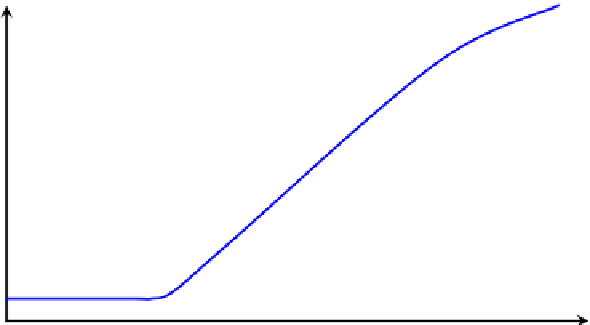Biomedical Engineering Reference
In-Depth Information
f
c
Re
p
f
c
Re
p
Low Reynolds number
Forchheimer flow
Low Reynolds number
Forchheimer flow
Darcy flow
Darcy flow
Re
p
Re
p
FIGURE 3.9
Friction factor for flow through a packed bed as a function of the particle Reynolds number. At low
to intermediate Reynolds number region, there is a transition from Darcy's flow where the friction factor is inversely
proportional to the flow rate, to inertial dominant flow (or Forchheimer flow) where the friction factor is constant.
high, the effect of the Darcy's region can be simplified and Ergun equation is commonly used
to compute the pressure drop, i.e.
D
t
2
d
p
1
ε
m
f
d
p
ru
f
c
¼
1:75 þ 150ð1
ε
Þ
(3.141)
ε
3
where
is the bedvoidage or porosityand
m
f
is the dynamic viscosityof the fluidmixture.Noting
that the flow transition exists in flow through packed beds, Liu et al. (Liu, S., Afacan, A. and
Masliyah, J.H. 1994 “Steady Incompressible Laminar Flow in Porous Media”, Chem. Eng. Sci.,
49, 3565
e
3586) proposed a modified equation for the friction factor,
ε
"
85:2 þ 0:69
#
Re
p
16
2
þ Re
p
d
p
ð1
ε
Þ
2
D
t
2
m
f
rd
p
u
f
c
¼
(3.142)
ε
11=3
where Re
p
is a particle Reynolds number defined by
Re
p
¼
1 þ
1
ε
1=2
1=2
rd
p
u
m
f
1
ε
ε
1=6
(3.143)
Equation
(3.142)
can describe the first two regions shown in
Fig. 3.9
quite well, including the
transition from the Darcy's flow to the Forchheimer flow.
3.15. IDEAL REACTORS
Reactors are “units” in which reaction occurs. Reactors can be operated in batch (no mass
flow into or out of the reactor) or flow modes. Flow reactors can operate between limits
of completely segregated (or unmixed) and completelymixed. Therefore, for simplicity in anal-
ysis, we define three types of idealized reactors based on the conditions of mixing and flow.











Search WWH ::

Custom Search